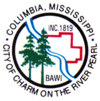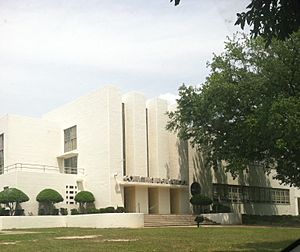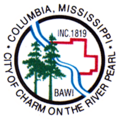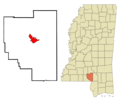Columbia, Mississippi facts for kids
Quick facts for kids
Columbia, Mississippi
|
|||
|---|---|---|---|
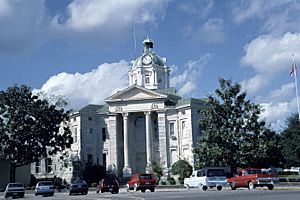
Marion County courthouse in Columbia
|
|||
|
|||

Location in Marion County and the state of Mississippi
|
|||
| Country | United States | ||
| State | Mississippi | ||
| County | Marion | ||
| Area | |||
| • Total | 6.76 sq mi (17.50 km2) | ||
| • Land | 6.75 sq mi (17.49 km2) | ||
| • Water | 0.00 sq mi (0.01 km2) | ||
| Elevation | 148 ft (45 m) | ||
| Population
(2020)
|
|||
| • Total | 5,864 | ||
| • Density | 868.23/sq mi (335.20/km2) | ||
| Time zone | UTC-6 (Central (CST)) | ||
| • Summer (DST) | UTC-5 (CDT) | ||
| ZIP code |
39429
|
||
| Area code(s) | 601 | ||
| FIPS code | 28-15340 | ||
| GNIS feature ID | 0668715 | ||
Columbia is a city in Marion County, Mississippi, United States. It is the main city and where the county government is located. Columbia was founded six years before Mississippi became a state. It was named after Columbia, South Carolina, because many of the first people who settled here came from that city. In 2020, about 5,864 people lived in Columbia.
Contents
History of Columbia
Columbia is the county seat of Marion County. This county was created in 1811 from Amite County. Early records show that families like the Lotts settled near the Pearl River in what is now Columbia around 1813.
The land where Columbia stands today was first bought in 1820 by William and John Lott. Other early landowners included James Phillips, Jr., and John Cooper.
Becoming a City and State Capital
Columbia officially became a city on June 25, 1819. It was the fourth city to be formed in the state of Mississippi. For a short time, from 1821 to 1822, Columbia was even the temporary capital of Mississippi. During this time, Governor Walter Leake was inaugurated here. Later, a new place called LeFleur's Bluff, which is now Jackson, was chosen as the permanent capital.
Life on the Pearl River
Columbia is known as "The City of Charm on the River Pearl." It has always been close to the Pearl River. This means the city has faced dangers from flooding. However, the county courthouse, which holds old records, has survived many challenges. It has seen wars, floods, tornadoes, and hurricanes. For its first 100 years, Columbia used the Pearl River to transport goods. The river used to be much deeper and wider than it is today.
Civil War and Community Spirit
During the Civil War, Union soldiers camped near Columbia. They took supplies from the local people, but the courthouse was not harmed.
Columbia is also known for its strong community spirit. During the civil rights movement, people in Columbia and Marion County held peaceful protests. This was thanks to Sheriff John Homer Willoughby, who insisted on non-violence.
Rodeo and White Squirrels
In 1935, Mississippi's first rodeo was held in Columbia. Later, in 2016, the Mississippi Rodeo Hall of Fame was started and is based in Columbia.
You might also spot some special animals in Columbia! Former Mississippi governor Hugh L. White, who was from Columbia, brought white squirrels to the area. You can still see them in Columbia City Park today.
Facing Natural Disasters
Columbia has faced several natural disasters. In 2005, Hurricane Katrina caused a lot of damage to the city. But once again, the courthouse survived. People in Columbia worked together to help each other during the long power outage. They cleared roads and helped neighbors.
In 2014, a strong tornado, called an EF3 tornado, hit Columbia. It caused widespread damage. After this, Columbia, Mississippi, and Columbia, South Carolina, helped each other out.
Geography of Columbia
Columbia is located in southern Mississippi. It sits on the east bank of the Pearl River. The city is about 84 miles (135 km) south of Jackson, the state capital. It is also about 118 miles (190 km) north of New Orleans.
Several highways pass through or near Columbia. U.S. Route 98 goes through the south side of the city. Mississippi Highway 13 runs through the center of Columbia. State Highway 44 also leads northeast from the city.
The city of Columbia covers a total area of about 6.8 square miles (18 km2). Most of this area is land, with only a very small part being water.
Climate in Columbia
Columbia has a humid subtropical climate. This means it has hot, humid summers and mild winters. The hottest temperature ever recorded in Columbia was 113 °F (45.0 °C) on June 7, 1915. The coldest temperature recorded was 4 °F (−15.6 °C) on January 11, 1982, and January 21, 1985.
| Climate data for Columbia, Mississippi, 1991–2020 normals, extremes 1903–present | |||||||||||||
|---|---|---|---|---|---|---|---|---|---|---|---|---|---|
| Month | Jan | Feb | Mar | Apr | May | Jun | Jul | Aug | Sep | Oct | Nov | Dec | Year |
| Record high °F (°C) | 85 (29) |
86 (30) |
90 (32) |
98 (37) |
102 (39) |
113 (45) |
107 (42) |
107 (42) |
108 (42) |
99 (37) |
91 (33) |
85 (29) |
113 (45) |
| Mean maximum °F (°C) | 76.2 (24.6) |
79.7 (26.5) |
84.0 (28.9) |
86.8 (30.4) |
92.3 (33.5) |
96.2 (35.7) |
97.3 (36.3) |
97.8 (36.6) |
95.5 (35.3) |
90.2 (32.3) |
82.7 (28.2) |
78.1 (25.6) |
99.1 (37.3) |
| Mean daily maximum °F (°C) | 59.9 (15.5) |
64.1 (17.8) |
71.3 (21.8) |
77.5 (25.3) |
84.6 (29.2) |
90.0 (32.2) |
91.6 (33.1) |
91.8 (33.2) |
88.1 (31.2) |
79.7 (26.5) |
69.1 (20.6) |
61.9 (16.6) |
77.5 (25.3) |
| Daily mean °F (°C) | 48.8 (9.3) |
52.8 (11.6) |
59.6 (15.3) |
66.1 (18.9) |
73.9 (23.3) |
80.1 (26.7) |
82.0 (27.8) |
81.9 (27.7) |
77.7 (25.4) |
67.7 (19.8) |
56.9 (13.8) |
51.0 (10.6) |
66.5 (19.2) |
| Mean daily minimum °F (°C) | 37.6 (3.1) |
41.5 (5.3) |
47.9 (8.8) |
54.6 (12.6) |
63.2 (17.3) |
70.2 (21.2) |
72.4 (22.4) |
72.0 (22.2) |
67.2 (19.6) |
55.6 (13.1) |
44.7 (7.1) |
40.0 (4.4) |
55.6 (13.1) |
| Mean minimum °F (°C) | 21.9 (−5.6) |
26.3 (−3.2) |
30.6 (−0.8) |
38.6 (3.7) |
48.9 (9.4) |
61.7 (16.5) |
67.0 (19.4) |
65.5 (18.6) |
54.4 (12.4) |
38.8 (3.8) |
29.6 (−1.3) |
26.1 (−3.3) |
20.1 (−6.6) |
| Record low °F (°C) | 4 (−16) |
11 (−12) |
16 (−9) |
23 (−5) |
37 (3) |
46 (8) |
53 (12) |
54 (12) |
36 (2) |
22 (−6) |
17 (−8) |
5 (−15) |
4 (−16) |
| Average precipitation inches (mm) | 6.52 (166) |
5.21 (132) |
5.72 (145) |
5.22 (133) |
4.35 (110) |
5.77 (147) |
6.05 (154) |
6.04 (153) |
3.60 (91) |
3.75 (95) |
3.86 (98) |
5.79 (147) |
61.88 (1,571) |
| Average precipitation days (≥ 0.01 in) | 11.2 | 10.1 | 9.8 | 8.0 | 8.7 | 11.1 | 12.5 | 10.9 | 7.9 | 6.9 | 8.1 | 10.1 | 115.3 |
| Source 1: NOAA | |||||||||||||
| Source 2: National Weather Service | |||||||||||||
People of Columbia
| Historical population | |||
|---|---|---|---|
| Census | Pop. | %± | |
| 1870 | 66 | — | |
| 1900 | 507 | — | |
| 1910 | 2,029 | 300.2% | |
| 1920 | 2,826 | 39.3% | |
| 1930 | 4,833 | 71.0% | |
| 1940 | 6,064 | 25.5% | |
| 1950 | 6,124 | 1.0% | |
| 1960 | 7,117 | 16.2% | |
| 1970 | 7,587 | 6.6% | |
| 1980 | 7,733 | 1.9% | |
| 1990 | 6,815 | −11.9% | |
| 2000 | 6,603 | −3.1% | |
| 2010 | 6,582 | −0.3% | |
| 2020 | 5,864 | −10.9% | |
| U.S. Decennial Census | |||
As of 2020, there were 5,864 people living in Columbia. These people made up 2,080 households and 1,155 families.
| Race | Num. | Perc. |
|---|---|---|
| White (non-Hispanic) | 3,042 | 51.88% |
| Black or African American (non-Hispanic) | 2,483 | 42.34% |
| Native American | 15 | 0.26% |
| Asian | 26 | 0.44% |
| Other/Mixed | 154 | 2.63% |
| Hispanic or Latino | 144 | 2.46% |
Education in Columbia
Most of Columbia is part of the Columbia School District. The public high school for the city is Columbia High School.
Before 1970, schools were separate for different racial groups. John J. Jefferson High School was for black students. In January 1970, schools were integrated, meaning students of all races could attend together. John J. Jefferson High School then became the middle school. Some white students left the public schools to attend a new private school called Columbia Academy.
There are also other public schools in Marion County. These include East Marion High School and West Marion High School. East Marion High School is just outside Columbia. West Marion High School is located near Foxworth.
Students in Marion County can also attend Pearl River Community College.
Famous People from Columbia
- Johnathan Abram, NFL safety
- Anthony Alford, former Major League Baseball player
- Ted Alford, former CFL player
- James W. Ball, 24th Chief of Ordnance for the United States Army
- Earl W. Bascom, rodeo champion, artist, inventor
- Texas Rose Bascom, rodeo performer, actress
- Weldon Bascom, rodeo champion
- Buddy Blair, former Major League Baseball player
- Terrell Buckley, American football coach and former player
- L. Russ Bush, theologian and author
- Gil Carmichael, businessman and political candidate
- Logan Cooke, NFL punter
- Maurice Dantin, attorney and political candidate
- Eagle Day, former NFL and CFL quarterback
- Peggy Dow, film actress and philanthropist
- Jim Dunaway, former NFL defensive tackle
- Joey Gathright, former Major League Baseball player
- Bobby Hamilton, former NFL defensive end
- S. J. Hathorn, former Mississippi politician
- Terry Irvin, former CFL cornerback
- Claudis James, former NFL player
- Kenny Johnson, former NFL player
- General Benjamin Lee, military leader
- Carey B. Maddox-Preston, social worker
- Sylvester Magee, reputedly the last living American slave
- Ken Morgan, Mississippi politician
- Jaheim Oatis, American football defensive tackle
- Joseph T. "Joe" Owens, former NFL defensive end
- Eddie Payton, former NFL running back
- Walter Payton, famous NFL player, born in Columbia
- Johnny Sims, former Arena Football League player
- Ethelbert I. Singley, former Mississippi politician
- Jackie Smith, former NFL tight end
- Ruby Terry, gospel musician
- Hugh L. White, former Columbia mayor and Mississippi Governor
Images for kids
See also
 In Spanish: Columbia (Misisipi) para niños
In Spanish: Columbia (Misisipi) para niños



